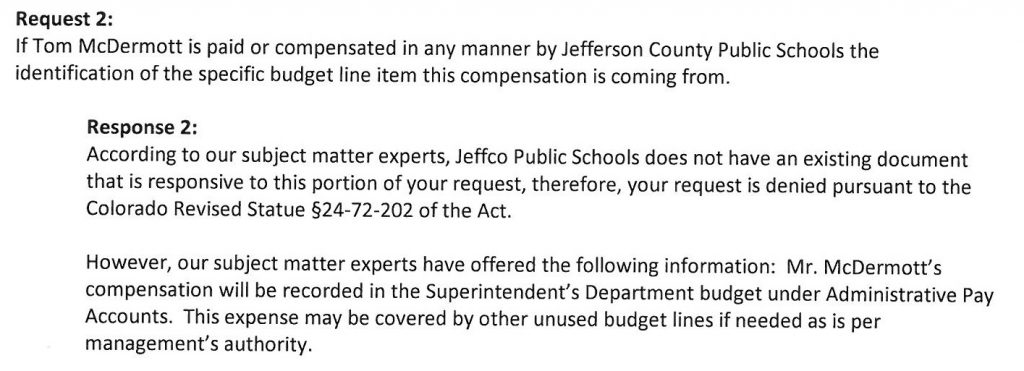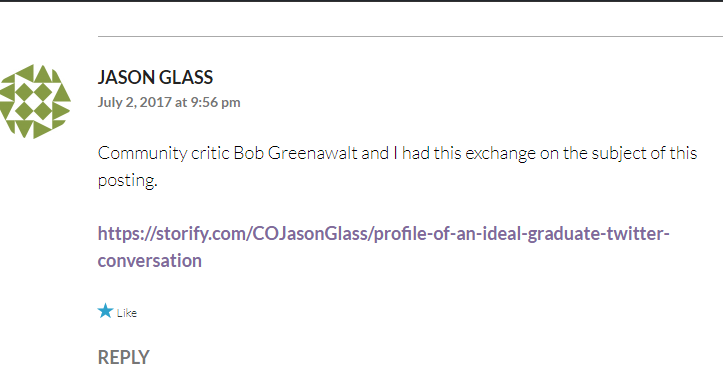Support Jeffco Kids (SJK) has recently written about how many groups and individuals Jason Glass has met with in his first 39 days as Jeffco Schools Superintendent. Well, Congratulations!
However, do you see any individuals or groups on this list who might possibly have a different perspective on education or the District than him, other than politicians? Has he reached out to anyone that might fit into that category?
I don’t see anyone that might fit into that category on the list that was so carefully curated by SJK.
Let’s start with the great “listening” tour. This tour was held during normal work hours for most working people (except the session late in the day in Evergreen) and during the summer. This conveniently brought out the teachers, stay-at-homes and retirees. Not a lot of working people made these meetings. When I brought this up to Glass during a Twitter exchange he said that he would consider holding meetings that might be more convenient for working people.

He may have considered holding additional meetings, but they certainly didn’t happen. In my opinion, he missed out on getting a different set of questions than he got from the teachers, retirees and stay-at-homes. Was this an act of omission or intentional?
What about the parents of the kid who was threatened at Governor’s Ranch Elementary School last year who would like a meeting with him to discuss? Glass’ schedule is SOOOO busy that he can’t fit these parents in until September 29th. Really??
Request to meet with Superintendent
When asked if she planned to meet with the superintendent, the mom said she put in a request.
“Dr. Glass has yet to reach out to us,” she said. “We were told the earliest Glass could meet with us was Sept. 29.”
Should we really believe that his schedule is completely booked for over 30 days and he can’t find 30 minutes to talk with parents who have a real issue? I’m sorry, but real “leaders” make time to talk with people who have issues and problems and don’t let those issues fester.
Has he reached out to ANYONE who might not agree with the current District staff and Board? If he really wants to listen he should hear different perspectives. I personally don’t know these people, but has he reached out to anyone from previous Boards (he’s talked to former principals, why not former Board members? Speaking of principals, did Glass reach out to former Wheat Ridge principal Griff Wirth who ran a great school but had issues with the District?)? Has he reached out to anyone from (http://www.eyeonjeffcoschoolboard.com/), Jeffco Students First or people with similar views? Or is it more convenient for him to just wish that the current Board “wins” in November, as he stated during the August Board retreat, so that he doesn’t have to engage people who may not agree with him or the Board?
Glass also knows that I have my own issues with members of the District staff who have blatantly and repeatedly lied to the Board, teachers and parents.
I started with comments posted to his blog on June 2nd and moved on to emails.
From his 3 Questions for Jeffco (https://advancejeffco.blog/2017/05/24/3-questions-jeffco/) blog I wrote:
“We have Cabinet members who intentionally deceive and lie (and I don’t use that word lightly) to the Board, teachers and parents.
Restore some community trust in Denver West by getting rid of the people there who have forgotten who their real constituents are – the students.
Note: I can back up my accusations of intentional deception and lying with documentation and evidence and would appreciate a meeting so I can give that to you.
Let’s talk when you’re settled in!”
He completely ignored this comment.
I reiterated my accusation in an August 10th email:
“ I don’t know what xxx told you and I certainly don’t know what he expects to accomplish with another parents meeting. The first one was an absolute disaster as he did nothing other than present inaccurate, misleading and deceptive numbers, essentially lying to the group. He was insulting, and parents and students alike called him out on his lies and attempts at deception. … Why won’t he have a discussion with the principal and SAC? Most likely it is because they will tell him that the numbers he is showing to people are intentionally deceptive and therefore complete lies.”
Don’t you think if someone accused members of your District staff of lying you would want to hear more?
Well, not Jason Glass!
In addition he has delayed and avoided getting people to talk about sustainable funding for the District’s HS GT program. Granted the Board directed collaborative approach to finding sustainable funding was made in February before Glass became Superintendent, but he clearly stated that he had been briefed on the issue during his “listening” tour, very early in his tenure. He now “owns” that issue and shouldn’t try to disclaim responsibility. However, to date the only thing he has done is to delay holding a collaborative discussion to some unknown date in the future, inexplicably tied to another meeting with only one set of stakeholders – the HS GT parents. That’s certainly not my definition of “collaborative” or even “listening” to all sides of the issue. And that’s not even talking about how badly the last District held meeting with the parents went .
He states that he has listened to me on my issues:


The funny thing is, I did check my emails. On July 25th he said that he was bringing the GT issue up to his Cabinet. Yet, his response to my follow-up inquiry of how the cabinet meeting went was to back track on getting people together to discuss the issue by holding another HS GT Parents’ meeting in September (still not scheduled by the way). And then, only AFTER that meeting get people to talk about the issue.
My question to him was WHY? Why not begin talking now with ALL of the stakeholders instead of just the HS GT parents?
There was no response to those questions.
Once again, it seems to me that he is delaying and avoiding a real discussion on difficult issues with people who may not agree with his views.
Therefore, I don’t count what he is doing as real “listening”.
Glass knows how to contact me via Twitter, email or phone. I’m happy to make time to discuss my issues. Until that happens, count me as someone who isn’t buying the “listening” bill of goods he’s selling and SJK has bought.
If Glass is only going to listen to people who support him and repeatedly delays and avoids listening to all sides of hard issues, can he, or his supporters, really claim that he’s listening?
Not in my book!






